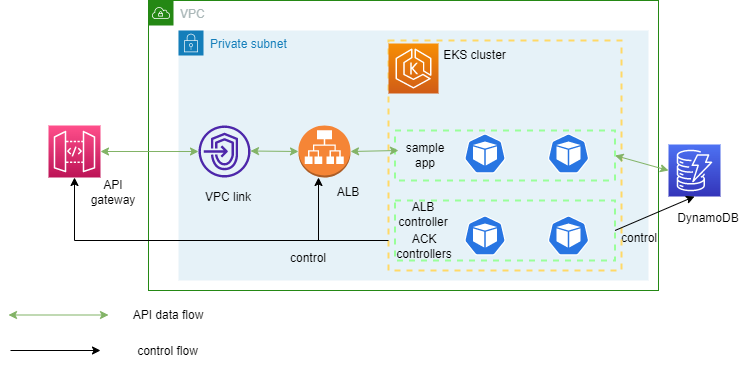# Complete Example
Configuration in this directory creates an AWS EKS cluster with the following ACK addons:
- ACK API Gateway controller
- ACK DynamoDB controller
- ACK RDS controller
- ACK S3 controller
In addition, this example provisions a sample application which demonstrates using the ACK controllers for resource provisioning.
The arhchitecture looks like this: <br>

## Prerequisites:
Ensure that you have the following tools installed locally:
1. [aws cli](https://docs.aws.amazon.com/cli/latest/userguide/install-cliv2.html)
2. [kubectl](https://Kubernetes.io/docs/tasks/tools/)
3. [terraform](https://learn.hashicorp.com/tutorials/terraform/install-cli)
## Deploy
To provision this example:
```sh
terraform init
terraform apply -var aws_region=<aws_region> # defaults to us-west-2
```
Enter `yes` at command prompt to apply
## Validate
The following command will update the `kubeconfig` on your local machine and allow you to interact with your EKS Cluster using `kubectl` to validate the CoreDNS deployment for Fargate.
1. Run `update-kubeconfig` command:
```sh
aws eks --region <REGION> update-kubeconfig --name <CLUSTER_NAME>
```
2. Verify ACK controllers for the services that are enabled are running:
```sh
kubectl get pods -A
NAMESPACE NAME READY STATUS RESTARTS AGE
ack-api-gateway ack-api-gateway-75499bfcfd-d5627 1/1 Running 0 26s
ack-dynamodb ack-dynamodb-76fdf5cf77-jpwd9 1/1 Running 0 26s
ack-rds ack-rds-85c7ccdbf6-tkpvz 1/1 Running 0 26s
ack-s3 ack-s3-7f4c79cbc8-g4tgl 1/1 Running 0 26s
kube-system aws-load-balancer-controller-596d8cb765-wwmzt 1/1 Running 0 26s
kube-system aws-load-balancer-controller-596d8cb765-zpkw5 1/1 Running 0 26s
kube-system aws-node-cvt8c 1/1 Running 0 26s
kube-system aws-node-dhk98 1/1 Running 0 26s
kube-system aws-node-fk4bb 1/1 Running 0 26s
kube-system coredns-57ff979f67-6vmrg 1/1 Running 0 26s
kube-system coredns-57ff979f67-xnwvn 1/1 Running 0 26s
kube-system kube-proxy-5ww6m 1/1 Running 0 26s
kube-system kube-proxy-84fk2 1/1 Running 0 26s
kube-system kube-proxy-jwwkl 1/1 Running 0 26s
```
## Sample Application Deployment
1. Update `sample-app/app.yaml` file and deploy:
```yaml
apiVersion: apps/v1
kind: Deployment
metadata:
name: deploy-api-dynamodb
namespace: ack-demo
... <Truncated for brevity>
env:
- name: tableName # match with your dynamodb table setting
value: ack-demo-table
- name: aws_region
value: "<same region as your eks cluster>"
```
```sh
kubectl apply -f sample-app/app.yaml
```
Note: app.yaml deploys a simple nodeJS image from docker hub. The source code can be found [here](https://github.com/season1946/ack-microservices/tree/main/sample-app-code)
2. Get the listener ARN of the provisioned ALB:
```sh
aws elbv2 describe-listeners \
--region <aws_region> \
--load-balancer-arn $(aws elbv2 describe-load-balancers \
--region <aws_region> \
--query "LoadBalancers[?contains(DNSName, '$(kubectl get ingress ingress-api-dynamodb -n ack-demo -o=jsonpath="{.status.loadBalancer.ingress[].hostname}")')].LoadBalancerArn" \
--output text) \
--query "Listeners[0].ListenerArn" \
--output text
```
> Replace `<aws_region>` in the command above with the correspoding region you deployed the cluster
3. Update `sample-app/apigwv2-httpapi.yaml` file and deploy:
```yaml
apiVersion: apigatewayv2.services.k8s.aws/v1alpha1
kind: Integration
metadata:
name: 'vpc-integration'
spec:
apiRef:
from:
name: 'ack-api'
integrationType: HTTP_PROXY
integrationURI: '<your ALB listener arn>'
integrationMethod: ANY
payloadFormatVersion: '1.0'
connectionID: '<your vpclink id>' # api_gatewayv2_vpc_link_id in Terraform output
connectionType: 'VPC_LINK'
```
```sh
kubectl apply -f sample-app/apigwv2-httpapi.yaml
```
Verify the status
```sh
echo API=$(kubectl get api.apigatewayv2.services.k8s.aws/ack-api -o jsonpath='{.status.conditions[?(@.type=="ACK.ResourceSynced")].status}')
echo Stage=$(kubectl get stage.apigatewayv2.services.k8s.aws/default-stage -o jsonpath='{.status.conditions[?(@.type=="ACK.ResourceSynced")].status}')
echo Route=$(kubectl get route.apigatewayv2.services.k8s.aws/ack-route-vpclink -o jsonpath='{.status.conditions[?(@.type=="ACK.ResourceSynced")].status}')
echo Integration=$(kubectl get integration.apigatewayv2.services.k8s.aws/vpc-integration -o jsonpath='{.status.conditions[?(@.type=="ACK.ResourceSynced")].status}')
```
Expected output
```
API=True
Stage=True
Route=True
Integration=True
```
4. Deploy DynamoDB table
```sh
kubectl apply -f sample-app/dynamodb-table.yaml
```
Verify the status
```sh
echo DynamoDB=$(kubectl get table.dynamodb.services.k8s.aws/ack-demo -o jsonpath='{.status.conditions[?(@.type=="ACK.ResourceSynced")].status}')
```
Expected output
```
DynamoDB=True
```
5. Test the API created. Get the api domain:
```sh
kubectl get -n ack-demo api ack-api -o jsonpath="{.status.apiEndpoint}"
```
6. Post data to dynamodb with `post` and query data with `get`
```
curl -X POST \
-H 'Content-Type: application/json' \
-d '{ "name": "external" }' \
$(kubectl get -n ack-demo api ack-api -o jsonpath="{.status.apiEndpoint}")/rows/add
curl $(kubectl get -n ack-demo api ack-api -o jsonpath="{.status.apiEndpoint}")/rows/all
```
## Destroy
To teardown and remove the resources created in this example:
```sh
kubectl delete -f sample-app
terraform destroy -target="module.eks_ack_addons" -target="module.eks_blueprints_kubernetes_addons" -auto-approve
terraform destroy -target="module.eks_blueprints" -auto-approve
terraform destroy -auto-approve
```